Jack Yan looks back at the cars of James Bond and what they convey about the character over the last 50 years
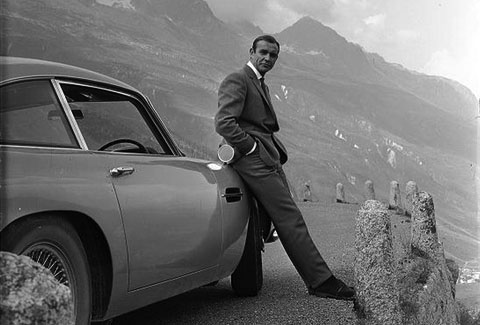
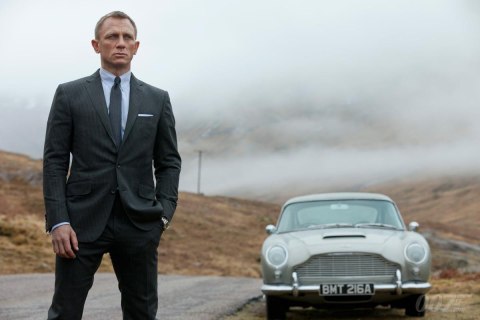
Copyright Danjaq LLC/United Artists Corp.
Top Sean Connery as James Bond at the Furka Pass, Switzerland, and the iconic Aston Martin DB5, during the making of Goldfinger (1964). Above Instead of Switzerland, it’s Scotland, and Daniel Craig pays homage to Sean Connery in a Skyfall publicity photo.
It’s not always easy, being a fan of the literary 007 as well as the cinematic one, to restrict a piece about the cars of James Bond to just the movies. And it’s awfully easy to say, ‘Sean Connery drove an Aston Martin DB5. Roger Moore drove a Lotus Esprit. ’Nuff said,’ on the different approaches of two of the actors.
It would also be very dull to list every car Bond has driven in 50 years of the movies, since a Sunbeam Alpine in Dr No to Daniel Craig piloting the DB5, complete with BMT 216A registration, in Skyfall (an auction of third-scale models hints at its destruction, incidentally). All this is on that repository of sometimes-useless information anyway, Wikipedia. But does something tie in Bond’s choice of motor car over the last half-decade?
Fleming was an enthusiast of either the automobile or someone who indulged in the descriptions of brand names and Bond’s daily habits. In this respect, James Bond, among all the other characteristics he has, is a marketing vehicle, even if Fleming did not concoct his hero to be a product-placement vehicle. However, the cars signalled something about Bond’s (and Fleming’s) prejudices: he liked his 1933 Bentley convertible with the Amherst Villiers supercharger, Felix Leiter’s Studillac, as well as the Aston Martin DB Mk III. His distaste for German cars is described in Moonraker as he gazes at Drax’s Mercedes-Benz, later the subject of a London car chase yet to be committed to celluloid. He thought the 300 S cabriolet too short to be graceful, but that Mercedes cars were ‘ruthless and majestic’. His old Bentley, 20 years older, was still somehow superior, not just because it could do the ton, but because in its day, it whipped the Mercedes-Benz SSKs.
The cinematic character has had more variety, since Bond is a product-placement vehicle. While Bond has a personal Bentley, seen in From Russia with Love (1963), it’s the Aston Martin DB5 that is most closely associated with the character. Goldfinger (1964), in which the DB5 appears first, was also the big Bond blockbuster. Consequently, the Aston Martin brand has been closely tied to Bond over the years. The DB5 reappears with Connery again in Thunderball (1965), Goldeneye (1995)— with a different registration (two digits off) and piloted by Pierce Brosnan—Tomorrow Never Dies (1997), again with Brosnan, Casino Royale (2006), with Daniel Craig, though with the steering wheel on the wrong side, and Skyfall (2012), with the un-British characteristic corrected.
And it’s maybe thanks to Connery that the DB5 has an air of masculinity. As his Bond tails Auric Goldfinger over the Furka Pass, while wearing his Anthony Sinclair suit, he epitomizes everything about the character. Well dressed, but rough if the occasion demanded, wearing, as Vesper Lynd criticized of Bond in Casino Royale, the Savile Row tailor’s suit with such disdain. Bond, after all, has an expense account, and his snobbery is that of the expense-account man. The DB5 was not the most powerful car in its day; it had a six, not a V8, and the image of Aston Martin was respectable (never mind what the reality was of its buyers). Jaguar was left to the flash Harrys, selling cars to the Kray brothers, for instance.
Only in 1959 did Aston win Le Mans, with Carroll Shelby and Roy Salvadori, in the days when rich men fielded teams. It was all very sensible, and grand touring cars were for those travelling the Continent and blasting up and down the motorways at the ton. The DB5 was particularly posh: it even had electric windows as standard.
Bond, in the guise of Connery, changed that, and it was the diamond-in-the-rough approach that Dr No’s director, Terence Young, created, and Guy Hamilton, Goldfinger’s director, was wise to retain. Driving the DB5 in Goldfinger, Aston Martin’s profile went global, and after the film’s release, it became the car brand that was most “pointed-at” on both sides of the Pond. The Goldfinger DB5 became known as the most famous car in the world, and Mendes—as well as this author—made do with miniature models sold by Corgi, themselves marvellous engineering feats in toy design. The DB5 went from a little-known car selling at twice the price of the Jaguar E-type to an icon.
Astons were used again for one-time Bond George Lazenby in On Her Majesty’s Secret Service (1969), specifically the DBS model, perfectly signalling not only a new Bond but the larger cars of the late 1960s, complementing the Contessa Teresa di Vicenzo’s Mercury Cougar, upgraded from the novel’s Lancia. You see DBSs in the background in Diamonds Are Forever (1971) as Q spoke to Bond on the phone, indicating MI6’s loyalty to the brand, but there was an absence till Timothy Dalton replaced Roger Moore in 1987’s The Living Daylights. Thanks to Aston Martin’s financial troubles in the intervening years, Dalton’s V8 Vantage and V8 Vantage Volante—chairman Victor Gauntlett’s own car—were little changed from what was in Q’s lab in 1971, instantly connecting Bond back to his heyday. It was a shrewd marketing move on the part of producer Albert R. ‘Cubby’ Broccoli, who insisted on the Aston Martin’s return.
Bond, then, had a few Lotuses in The Spy Who Loved Me (1977) and For Your Eyes Only (1981), when he was played by Roger Moore. It’s a decision criticized in hindsight, especially as Moore’s Bond waltzed through action scenes winking at the camera, though at least he did not yield a camera himself in the guise of Dean Martin’s Matt Helm. But for anyone growing up in the 1970s, there was nothing “un-masculine” about the Lotus and its four cylinders. Remember this was a decade with fuel crises, and a DOHC four made plenty of sense. The Lotus out-handled most cars at the price—word has it that the man from Lotus drove some of the stunts in The Spy Who Loved Me because the car was capable of more than what the stuntmen could throw at it—and the angular Giugiaro looks were oh-so-modern in 1977. Of course it was not a V8, as later Astons would be, but there’s a similar notion today that it’s not the number of cylinders that count, in the wake of another round of soaring fuel prices. The Lotus Esprit, then, does not lack a Bondian quality, because it could handle any manœuvre, and it was as sharp in looks as Moore’s big flares and lapels.
continued below
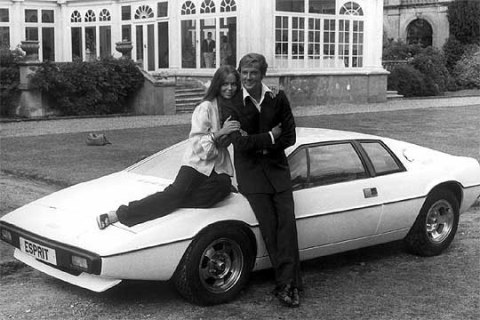


Copyright Danjaq LLC/United Artists Corp.
From top Roger Moore and Barbara Bach pose with the Lotus Esprit in a publicity shot for The Spy Who Loved Me. Pierce Brosnan in the most lethargic Bond car that Q has assigned him: the four-cylinder BMW Z3 in Goldeneye. In Die Another Day, Brosnan gets the top Aston Martin, the V12 Vanquish.
Q Branch, meanwhile, gave Pierce Brosnan a number of German cars, thanks to a three-movie deal with BMW. If Moore’s Esprits were considered lightweights, then what can one say of Brosnan’s unfortunate Z3 1·9 in Goldeneye? Yes, his masculinity is redeemed because he has a DB5 in the opening chase (it miraculously keeps up with a Ferrari F355), but the Z3, known now for being a wee bit prissy, is the most un-Bondian vehicle Bond has ever been given by the Quartermaster. Its only gadget on screen is a radar telling Bond when a plane is nearing, and while all the other toys—Stinger missiles in the headlights are mentioned—they are never seen. The Z3, then, does nothing other than tell Bond what he would know by glancing at the rear-view mirror and using his ears to hear the plane roaring overhead.
It’s not much of an improvement in Tomorrow Never Dies, with a BMW 750iL assigned to Bond, who is undercover as a banker. He needs to look boring, and while the 750iL is far better in gadget terms, it just doesn’t seem Bondian. In fact, Bond picks it up while the British Secret Service is posing as an Avis rental outlet in Hamburg, and he returns it to another Avis branch. It is more rental-car, albeit the sort of expensive rental cars that we imagine Germans can easily pick up in Bavaria in some parallel universe.
With the BMW Z8 not actually in production when The World Is Not Enough (1999) was released, some clever fellows used Jaguar XJ6 chassis to mock up some of the ones used in the film, so you could argue that the car was actually British. But it’s not too bad: the Z8 at least looks sporting, and it could be considered in the same class as either the Aston or the Lotus, but there’s something with all three of the German entries. The literary Bond would hate them: the heaviness inherent in the lines, which signal solidity to people who love German cars, but not the faux snobbery of Fleming’s character who expects his cars to look graceful.
Bond doesn’t seem affectionate toward any of the BMWs, though he is saddened when the Z8 meets its maker when sliced in half by the villains. And deep down, perhaps the scriptwriters didn’t want to show that Bond was that thrilled about getting in to a German car. Bond is far more impressed with Q—now played by John Cleese—gives him an Aston Martin V12 Vanquish in Die Another Day (2002), one that can turn invisible as Bond went into the science-fiction–fantasy realm, and when he morphs into Daniel Craig for Casino Royale, there’s a faint smile (is there any other from Craig?) and a ‘Thank you, M’ as he samples his DBS (no relation to the earlier model).
The Vanquish and DBS are V12s: since Tadek Marek’s V8 was put in to Aston Martins in the early 1970s (just in time for the fuel crisis), Astons have been hairier, less politically correct, and assume you don’t mind 6 mpg and paying $300 in petrol a week (source: unscientific Lucire road test in 2007 of the DB9). While there’s that “junior” Aston, the V8 Vantage, they still make brutal noises—the V8 more so, with the way the exhaust works. And thus, they represent Bond in the modern era: a character who is politically incorrect and unashamedly so. M—Dame Judi Dench in 1995’s Goldeneye—might have criticized Brosnan’s Bond for being a ‘sexist, misogynist dinosaur’ and tried to emasculate him in a Z3, but that Bond was never that jarring with his era, the decade after Stallone, Schwarzenegger, van Damme and Lundgren made it OK for action heroes to have pectorals the size of American states. It took Aston to signal properly that the alpha-male Bond is back (perhaps Connery was the last) in the guise of Craig, enough to put the pretenders back in their place, and balancing both the tailored side of the character and his brute force—his vintage DB5 and new DBS signalling them.
The cars of James Bond, then, complete the picture, even in the cinematic world. It’s why the Brosnan era might be thought of as commercialized fodder: Bond-as-product-placement-vehicle all sanitized with the star never letting a hair fall out of place. Even when Brosnan’s Bond was tortured at the beginning of Die Another Day, he was bearded and broken for a few moments till a Philips electric razor cleaned him all up before the plot actually got under way. The BMWs never complemented the image, and Bond’s Sunbeam Alpine suddenly looks butch in comparison.
And what of Skyfall? There’s no word on the new Vanquish, the DBS’s replacement, appearing in the movie, and Mendes is keen to photograph Bond in certain scenes that transport us back to the ’60s. The DB5 is confirmed, but Aston Martin tells us that among the Vanquish’s colour options is something called Skyfall Silver. Is that a clue?
The new Vanquish, too, has all the qualifications for the politically incorrect Bond: 573 PS under the bonnet, with fuel economy figures unreleased. Under our driving conditions—usually pretty hard—it’ll probably not improve on the 6 mpg we were getting in the DB9. Bond is saved not by his wits or Roger Moore’s safari suit, but by the expense account courtesy of the British taxpayer.
We can only hope that the latest cinematic Bond has the two cars to reflect his two personalities—and, as the Aston Martin is graceful, lithe, stylish and powerful, the literary Bond might approve, too. •
Jack Yan is publisher of Lucire.

Copyright Danjaq LLC/United Artists Corp.
Above Daniel Craig in his first outing as 007 with the then-new Aston Martin DBS.
Originally published in Lucire.

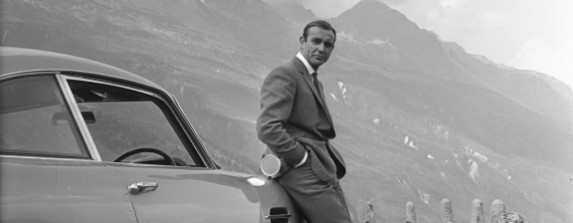
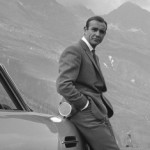
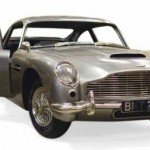
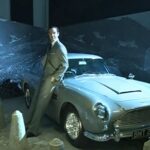
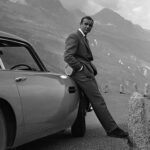
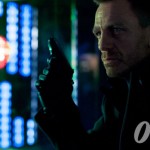
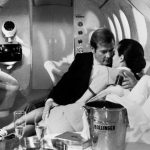
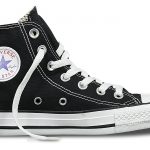

1 Pingback